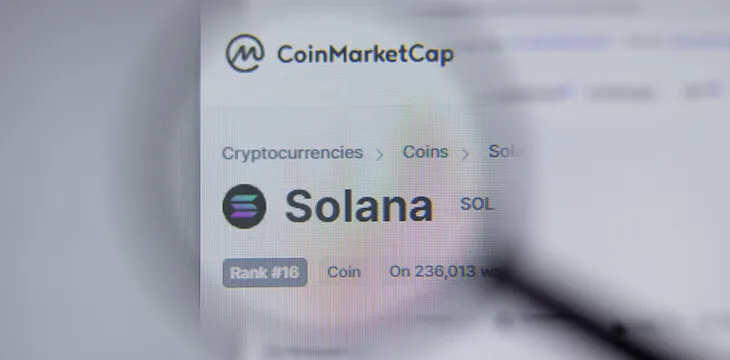|
Getting your Trinity Audio player ready...
|
If you’ve been involved in the digital currency space for more than a few years, you’ve seen your fair share of hype cycles. From IOTA to EOS, to XRP, to Solana, there’s always a new killer blockchain that’s going to change everything. Speculators flock to them, pumping token prices by thousands of percent, but inevitably, it all comes crashing down or fades into insignificance as technical limitations come up against reality.
This year, Solana has been the main hype train in the digital currency space. Yet, less than 72 hours ago, the Solana blockchain came to a grinding halt, the developers hit the off button, and the entire ecosystem froze in space and time as Solana devs tried to figure out what had gone wrong.
Like most events in this space, the large media outlets owned by the Digital Currency Group and others largely ignored it or downplayed its significance, and a stream of misinformation promoted by those who stand to gain from Solana’s token price remaining high flooded social media channels.
So, what really happened? Why did Solana implode? And what does it mean for its future?
What happened to the Solana blockchain?
According to an official Twitter statement from Solana Status, the network experienced an increase in transactions that peaked at 400k per second. These transactions allegedly flooded the transaction processing queue and caused the network to fork. In turn, the forking led to excessive memory consumption and knocked some nodes offline.
1/ Solana Mainnet Beta encountered a large increase in transaction load which peaked at 400,000 TPS. These transactions flooded the transaction processing queue, and lack of prioritization of network-critical messaging caused the network to start forking.
— Solana Status (@SolanaStatus) September 14, 2021
This is tech-speak for the blockchain crashed and burned because it couldn’t handle the heat and is poorly designed. So, what did the Solana validator community do? They turned it off and on again, just like what happens when you call tech support because your Wi-Fi isn’t working properly.
This raises serious questions about Solana’s key claims, namely that it is fast, secure, and censorship-resistant, some of the favorite buzzwords in the digital currency industry. If validators can switch the network off, in what way is Solana censorship resistant? And how can it claim to be secure when a large number of transactions caused it to fail spectacularly?
Yet, it’s not even clear if Solana really did experience such a large volume of transactions. Justin Bons, founder of Cyber Capital, called Solana out on social media and claimed the large transaction volume explanation was a lie. According to Bons, the on-chain evidence does not support these claims.
I am calling out the false claim by @solana that the network was brought down by doing 400k TPS.
This is objectively false.
If the TXs do not make it into the blockchain, you cannot claim that as the TPS limit.
TXs in mempool do not count towards TPS!
Evidence is all onchain: pic.twitter.com/OlCrEM8vF2
— Justin Bons (@Justin_Bons) September 15, 2021
This is all very confusing, and it will probably take some time before it’s clear what really happened to Solana, but there are some key lessons that we can take away from this situation right now.
- Solana isn’t the technically superior blockchain it’s made out to be. Like Cardano, EOS, and many other hype trains over the years, it has made zero fundamental improvements on the original Bitcoin protocol. 400k TPS isn’t enough to run email, let alone act as the backbone for a new internet and financial system.
- Solana’s PR people are willing to lie or at least fudge the truth in order to save face. Let’s give them the benefit of the doubt until the dust settles, and a proper audit of what happened can be conducted, but it’s clear that there are plenty of skeptics about their initial claims.
- Developers once again have to learn that building on protocols that aren’t set in stone, and that can be tinkered with isn’t a good choice. What happens if during the next time when the centralized protocol developers switch off the Solana blockchain, that it never comes back online? Hard-working application devs who are investing lots of precious time and resources into building on these chains need to ask themselves some serious questions right now.
Solana devs, we need to talk
If you’re a Solana developer or a potential Solana developer, I appeal to you to check out the BSV enterprise blockchain. It’s the original Bitcoin protocol, and it can’t be altered, played with, or changed. It scales infinitely and hasn’t experienced any technical difficulties despite a massive increase in transactions (1M+ daily) recently. You can build on BSV without any fears of it failing, violating the law, or being switched off by centralized powers outside of your control. It’s been running successfully since 2009 and will still be running in 2109.
BSV gets some bad press from vested interests that want to promote alternative blockchains like Ethereum, Cardano, and Solana. Yet, all three have repeatedly failed to live up to expectations, and you should be wondering by now if perhaps they aren’t all they’re cracked up to be. What harm can it do to look into BSV, assess its technical capabilities for yourself, and perhaps test it? There’s no need to commit to anything yet, but if you’re having doubts about Solana, you should look into BSV as one of your potential options.
Here are some facts to consider:
- BSV is battle-ready and combat tested. Its honest nodes successfully repelled an illegal reorg attack not long ago, and it has been processing over a million transactions daily without missing a beat.
- It’s fully compliant with all existing laws and always will be.
- You’ll find a thriving ecosystem of BSV app development, including a phenomenal blockchain game called CryptoFights.
- BSV has some awesome startup incubators like Satoshi Block Dojo who can help you make your ideas a reality.
- BSV never hits a scaling ceiling because it has unbounded block sizes. That’s the way Satoshi designed it to be.
Solana will come and go
Like Ethereum, EOS, and others, Solana will come and go. But when it’s all said and done, BSV will be the last protocol standing. Don’t take anybody’s word for it; check it out for yourself, ask the growing number of developers in the BSV ecosystem, or just listen to the people who have already made the transition due to the technical limitations of other blockchains.
In Chinese, the word for crisis is composed of two characters; one is danger and the other is opportunity. Solana’s epic failure could be the wake-up call many of you need to go in a new direction while there’s still time. Everything is not as it seems in this industry, and the future is going to look very different than what you’re being told. There will be one global chain, one base layer protocol, and it won’t be Solana.
Take the time to learn how Bitcoin works and what it’s capable of by listening to its inventor. At this stage, what have you got to lose?

 07-05-2025
07-05-2025 





